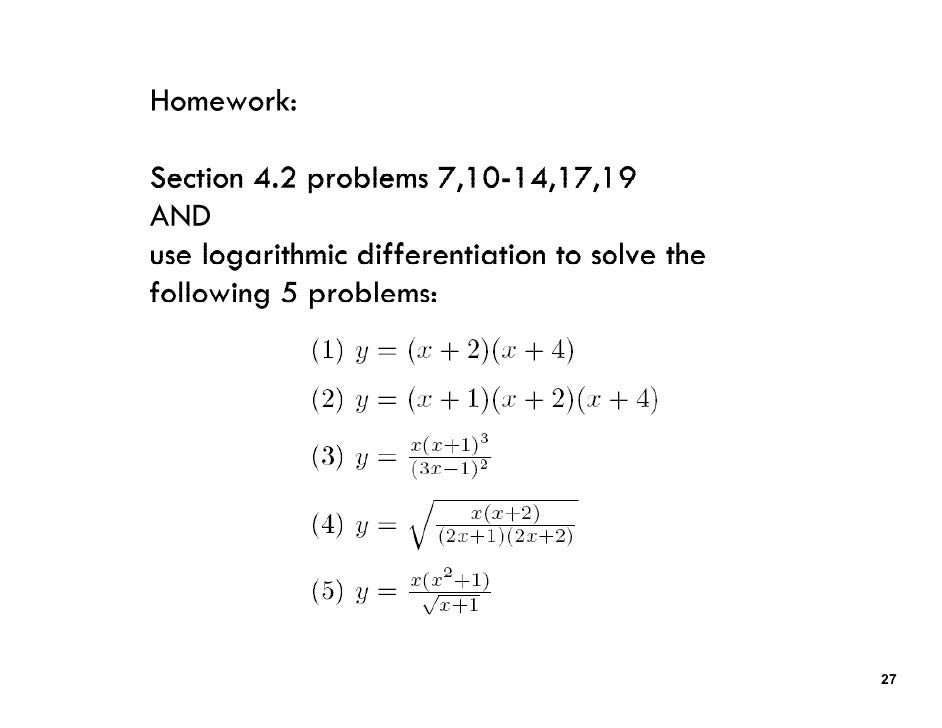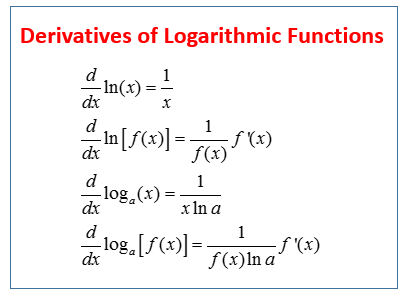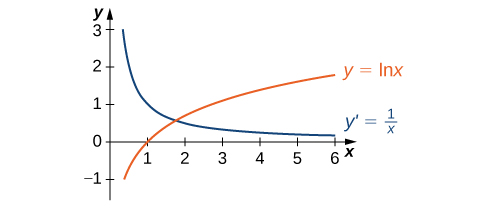Free Logarithms Calculator - Simplify logarithmic expressions using algebraic rules step-by-step This website uses cookies to ensure you get the best experience. By using this website, you agree to our Cookie Policy.
- Logarithmic Differentiation Calculator
- Logarithmic Differentiation Calculator Wolfram
- Logarithmic Differentiation Calculator With Steps
- How To Do Logarithmic Differentiation
The calculation of derivatives of functions involving products, powers or quotients can be simplified with the logarithmic differentiation (because of the properties of logarithms). Let's first see how to differentiate functions that already have product and/or quotient under logarithm. Free derivative calculator - differentiate functions with all the steps. Type in any function derivative to get the solution, steps and graph. In calculus, the quotient rule is a method of finding the derivative of a function that is the ratio of two differentiable functions. Let f(x)=g(x)/h(x), where both g and h are differentiable and h(x)≠0. Free implicit derivative calculator - implicit differentiation solver step-by-step This website uses cookies to ensure you get the best experience. By using this website, you agree to our Cookie Policy.
Show All NotesHide All NotesSection 3-13 : Logarithmic Differentiation
There is one last topic to discuss in this section. Taking the derivatives of some complicated functions can be simplified by using logarithms. This is called logarithmic differentiation.
It’s easiest to see how this works in an example.
Example 1 Differentiate the function. [y = frac{{{x^5}}}{{left( {1 - 10x} right)sqrt {{x^2} + 2} }}] Show SolutionDifferentiating this function could be done with a product rule and a quotient rule. However, that would be a fairly messy process. We can simplify things somewhat by taking logarithms of both sides.
[ln y = ln left( {frac{{{x^5}}}{{left( {1 - 10x} right)sqrt {{x^2} + 2} }}} right)]Of course, this isn’t really simpler. What we need to do is use the properties of logarithms to expand the right side as follows.
[begin{align*}ln y & = ln left( {{x^5}} right) - ln left( {left( {1 - 10x} right)sqrt {{x^2} + 2} } right) ln y & = ln left( {{x^5}} right) - ln left( {1 - 10x} right) - ln left( {sqrt {{x^2} + 2} } right)end{align*}]This doesn’t look all that simple. However, the differentiation process will be simpler. What we need to do at this point is differentiate both sides with respect to (x). Note that this is really implicit differentiation.
[begin{align*}frac{{y'}}{y} & = frac{{5{x^4}}}{{{x^5}}} - frac{{ - 10}}{{1 - 10x}} - frac{{frac{1}{2}{{left( {{x^2} + 2} right)}^{ - frac{1}{2}}}left( {2x} right)}}{{{{left( {{x^2} + 2} right)}^{frac{1}{2}}}}} frac{{y'}}{y} & = frac{5}{x} + frac{{10}}{{1 - 10x}} - frac{x}{{{x^2} + 2}}end{align*}]
To finish the problem all that we need to do is multiply both sides by (y) and the plug in for (y) since we do know what that is.
[begin{align*}y' & = yleft( {frac{5}{x} + frac{{10}}{{1 - 10x}} - frac{x}{{{x^2} + 2}}} right) & = frac{{{x^5}}}{{left( {1 - 10x} right)sqrt {{x^2} + 2} }}left( {frac{5}{x} + frac{{10}}{{1 - 10x}} - frac{x}{{{x^2} + 2}}} right)end{align*}]Depending upon the person, doing this would probably be slightly easier than doing both the product and quotient rule. The answer is almost definitely simpler than what we would have gotten using the product and quotient rule.
So, as the first example has shown we can use logarithmic differentiation to avoid using the product rule and/or quotient rule.
We can also use logarithmic differentiation to differentiate functions in the form.
[y = {left( {fleft( x right)} right)^{gleft( x right)}}]Let’s take a quick look at a simple example of this.
Example 2 Differentiate (y = {x^x}). Show SolutionLogarithmic Differentiation Calculator

We’ve seen two functions similar to this at this point.
[frac{d}{{dx}}left( {{x^n}} right) = n{x^{n - 1}}hspace{0.5in}frac{d}{{dx}}left( {{a^x}} right) = {a^x}ln a]Neither of these two will work here since both require either the base or the exponent to be a constant. In this case both the base and the exponent are variables and so we have no way to differentiate this function using only known rules from previous sections.
With logarithmic differentiation we can do this however. First take the logarithm of both sides as we did in the first example and use the logarithm properties to simplify things a little.
[begin{align*}ln y & = ln {x^x} ln y & = xln xend{align*}]Differentiate both sides using implicit differentiation.
[frac{{y'}}{y} = ln x + xleft( {frac{1}{x}} right) = ln x + 1]As with the first example multiply by (y) and substitute back in for (y).
[begin{align*}y' & = yleft( {1 + ln x} right) & = {x^x}left( {1 + ln x} right)end{align*}]Let’s take a look at a more complicated example of this.
Example 3 Differentiate (y = {left( {1 - 3x} right)^{cos left( x right)}}). Show SolutionNow, this looks much more complicated than the previous example, but is in fact only slightly more complicated. The process is pretty much identical, so we first take the log of both sides and then simplify the right side.
[ln y = ln left[ {{{left( {1 - 3x} right)}^{cos left( x right)}}} right] = cos left( x right)ln left( {1 - 3x} right)]
Next, do some implicit differentiation.
[frac{{y'}}{y} = - sin left( x right)ln left( {1 - 3x} right) + cos left( x right)frac{{ - 3}}{{1 - 3x}} = - sin left( x right)ln left( {1 - 3x} right) - cos left( x right)frac{3}{{1 - 3x}}]
Finally, solve for (y') and substitute back in for (y).
 [begin{align*}y' & = - yleft( {sin left( x right)ln left( {1 - 3x} right) + cos left( x right)frac{3}{{1 - 3x}}} right) & = - {left( {1 - 3x} right)^{cos left( x right)}}left( {sin left( x right)ln left( {1 - 3x} right) + cos left( x right)frac{3}{{1 - 3x}}} right)end{align*}]
[begin{align*}y' & = - yleft( {sin left( x right)ln left( {1 - 3x} right) + cos left( x right)frac{3}{{1 - 3x}}} right) & = - {left( {1 - 3x} right)^{cos left( x right)}}left( {sin left( x right)ln left( {1 - 3x} right) + cos left( x right)frac{3}{{1 - 3x}}} right)end{align*}] A messy answer but there it is.
We’ll close this section out with a quick recap of all the various ways we’ve seen of differentiating functions with exponents. It is important to not get all of these confused.
Logarithmic Differentiation Calculator Wolfram
[begin{array}{ll}displaystyle frac{d}{{dx}}left( {{a^b}} right) = 0 & hspace{1.0in}{mbox{This is a constant}} displaystyle frac{d}{{dx}}left( {{x^n}} right) = n{x^{n - 1}} & hspace{1.0in}{mbox{Power Rule}} displaystyle frac{d}{{dx}}left( {{a^x}} right) = {a^x}ln a & hspace{1.0in}{mbox{Derivative of an exponential function}} displaystyle frac{d}{{dx}}left( {{x^x}} right) = {x^x}left( {1 + ln x} right) & hspace{1.0in}{mbox{Logarithmic Differentiation}}end{array}]Logarithmic Differentiation Calculator With Steps
It is sometimes easy to get these various functions confused and use the wrong rule for differentiation. Always remember that each rule has very specific rules for where the variable and constants must be. For example, the Power Rule requires that the base be a variable and the exponent be a constant, while the exponential function requires exactly the opposite.
How To Do Logarithmic Differentiation
If you can keep straight all the rules you can’t go wrong with these.
